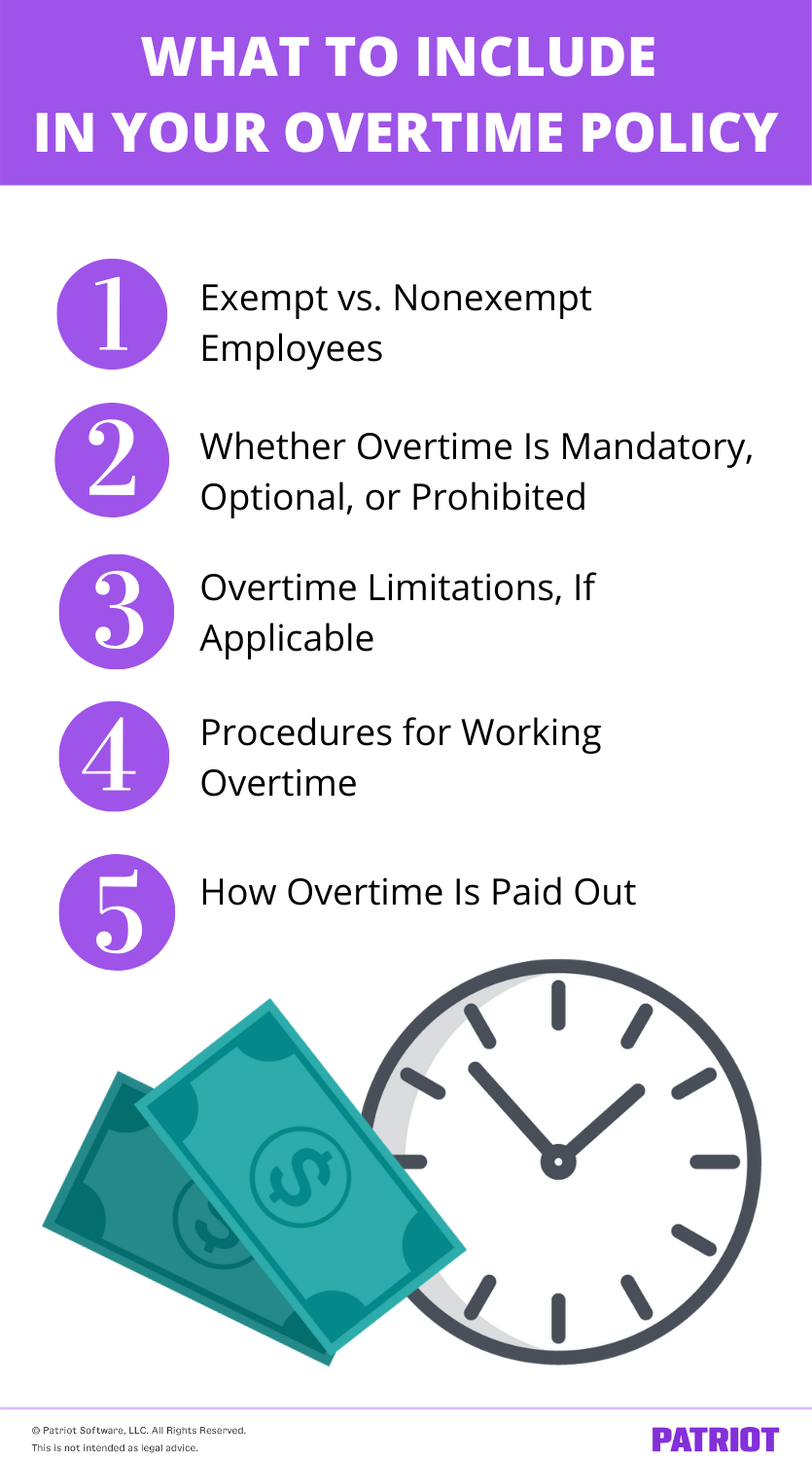Do you have nonexempt employees in your business? If so, you need an overtime policy to set some ground rules. Your employee overtime policy should address things like limits and who can work overtime.
Why do you need a company overtime policy?
Without a policy, your employees may not know whether working overtime is mandatory, optional, limited, or prohibited.
When you have nonexempt employees, you must pay them overtime pay for any hours worked over 40 in a workweek. Overtime wages are 1.5 times the employee’s regular hourly rate. Exempt employees may work overtime hours, but they do not receive overtime pay for extra hours worked.
Your policy must address how you handle overtime hours for both exempt and nonexempt employees.
First, let’s take a look at who is exempt from overtime pay. Employees must meet three requirements to be exempt from overtime wages:
- Paid on a salary basis
- Earn at least $35,568 per year
- Have executive, administrative, or professional job duties
If you have employees who do not meet all three of these requirements, you must give them overtime pay.
So, why do you need an overtime management policy? Your overtime policy acts as a point of reference for employees who have questions about your overtime procedures.
Drafting your overtime policy
Your employees should be able to find your overtime policy and procedure information in the employee handbook.
If you need help coming up with things to include in your policy, look no further. Your overtime policy should mention the following information:
- Exempt vs. nonexempt employees
- Whether overtime is mandatory, optional or prohibited
- Overtime limitations, if applicable
- Procedures for working overtime
- How overtime is paid out
Learn more about these important pieces of information you might include in your policy.

1. Exempt vs. nonexempt employees
Your overtime policy must address the difference between exempt and nonexempt employees. Explain that nonexempt employees receive overtime wages for hours over 40 worked while exempt employees don’t.
In addition to outlining this difference, you should also tell employees which classification they are when you hire them.
2. Whether overtime is mandatory, optional, or prohibited
Depending on your business, you might want to make overtime mandatory, optional, or off-limits.
If you need employees to work overtime, particularly during the busy seasons, you might establish weeks with mandatory overtime. State how many hours of overtime each employee is required to work during these times.
Some businesses don’t need employees to work overtime, but they don’t outright ban it. If this sounds like something that would be the case in your business, you might make overtime optional.
Overtime for nonexempt employees can get expensive. To avoid these high costs, you might ban employees from working overtime.
3. Overtime limitations, if applicable
Instead of completely banning employees from working overtime, you might decide to limit the number of overtime hours they can work. If you do decide to limit overtime, add it to your policy.
For example, you can specify that your employees can work a maximum of four overtime hours each week (per employee).
By limiting overtime hours, you can control the amount of overtime pay you need to dole out to your employees.
4. Procedures for working overtime
Your employee overtime policy should dive into specifics. Mention how employees request to work overtime, whether there is an overtime rotation, and how employees report overtime hours worked.
Specify whether you have an overtime approval policy—do employees need to get permission before working extra hours in a workweek? If employees need to get approval before working overtime, explain how.
Some businesses use an overtime rotation policy to split up overtime hours among different employees or departments. If you rotate who gets to work overtime, outline it in your policy.
Don’t forget to explain how employees report their overtime hours. Will they clock-in using a time clock or mark their hours in an online time and attendance system?
5. How overtime is paid out
Generally, overtime wages are included in a nonexempt employee’s regular wages when you run payroll.
If you forget to pay overtime wages, you must provide back pay to the employee. When you pay an employee back pay, you can run a separate payroll for the wages or include them in the employee’s next paycheck.
Also, remember to withhold taxes from overtime wages. Because overtime pay is a type of supplemental pay, you can either withhold taxes like you would regular wages or use the supplemental tax rate of 22%.
Your policy should specify how nonexempt employees receive their overtime pay. And, state what employees should do if they think there is a problem with their overtime wages.
Overtime policy recap
Remember to answer these key questions in your policy:
- Is overtime mandatory, optional, or prohibited?
- Do employees need to get permission before working overtime?
- What is the overtime approval policy?
- How many hours of overtime can employees work?
- How should employees submit their overtime hours?
- When and how do employees receive their overtime wages?
If your non-exempt employees work overtime, you need to pay them overtime wages. But don’t worry—Patriot’s online payroll calculates overtime pay for you. Say goodbye to manual calculations and hello to streamlined payroll. And, our HR software add-on lets you share important documents (like an overtime policy) with your employees. Try both for free!
This is not intended as legal advice; for more information, please click here.
